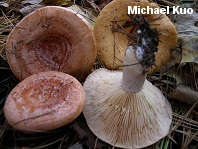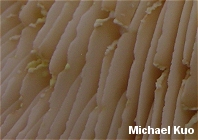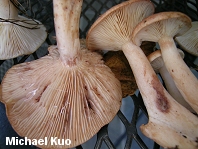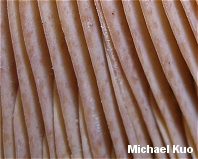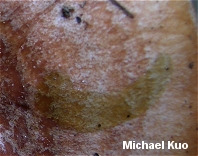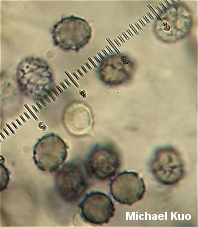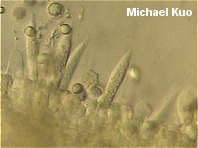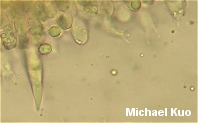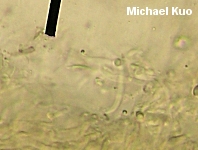| Major Groups > Gilled Mushrooms > Pale-Spored > Lactarius > Lactarius vinaceorufescens |

|
Lactarius vinaceorufescens [ Basidiomycota > Russulales > Russulaceae > Lactarius . . . ] by Michael Kuo This common pine lover from eastern North America has white milk that turns yellow after exposure to air, usually within a few seconds. The cap is cinnamon pink or darker red, and usually displays concentric zones of color, at least when young. The stem is smooth, without potholes, and the gills become spotted with pinkish to cinnamon discolorations. Lactarius chrysorrheus is very similar, but is associated with oaks. Additionally, it has paler colors, gills that do not discolor, and a more southerly range. In the conifer forests of northern Michigan, Lactarius vinaceorufescens is a prolific late summer and fall species, often appearing in large numbers along with Lactarius deliciosus var. deterrimus and Lactarius thyinos. On the West Coast, Lactarius xanthogalactus is a similar species; it appears in older western field guides (e.g. Arora 1986) as Lactarius vinaceorufescens. However, Methven (1997) argues that the California species is distinct because it lacks the red staining of Lactarius vinaceorufescens, and because it associates with coast live oak and tanoak rather than pines. Description: Ecology: Mycorrhizal with pines--especially eastern white pine; growing scattered or gregariously; summer and fall; fairly widely distributed in northeastern North America. Cap: 4-12 cm; broadly convex with an inrolled margin when young; becoming shallowly depressed or vase-shaped, with an uplifted margin; slimy or sticky when fresh; bald; cinnamon pink, cinnamon, or reddish brown; typically with vague concentric zones of color, at least when young. Gills: Beginning to run down the stem; close; pale at first, developing pinkish to brownish stains, and often becoming reddish to reddish brown overall with age. Stem: 4-7 cm long; 1-2.5 cm thick; equal, or enlarging towards the base; bald; without potholes; whitish, becoming colored like the cap with age. Flesh: White; firm; staining yellow when sliced. Milk: White, becoming yellow within a few seconds on exposure to air; staining white paper yellow. Odor and Taste: Odor not distinctive; taste acrid or peppery (sometimes slowly so). Chemical Reactions: KOH olive (or sometimes negative) on cap surface. Spore Print: Whitish to yellowish. Microscopic Features: Spores 6.5-9 x 5-7 µ; broadly ellipsoid or subglobose; ornamentation 0.5-1 µ high, as amyloid warts and ridges that sometimes form partial reticula. Pleuromacrocystidia to about 70 µ long; clavate to fusoid. Cheilomacrocystidia similar but shorter. Pileipellis an ixocutis. REFERENCES: Smith, 1960. (Hesler & Smith, 1979; Smith, Smith & Weber, 1979; Phillips, 1991/2005; Lincoff, 1992; Roody, 2003; McNeil, 2006.) Herb. Kuo 07259403, 09110417, 10280706, 10260901, 10091002. This site contains no information about the edibility or toxicity of mushrooms. |
© MushroomExpert.Com |
|
Cite this page as: Kuo, M. (2015, May). Lactarius vinaceorufescens. Retrieved from the MushroomExpert.Com Web site: http://www.mushroomexpert.com/lactarius_vinaceorufescens.html |
